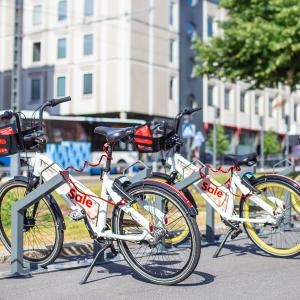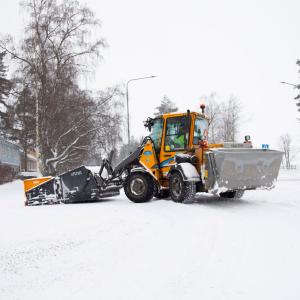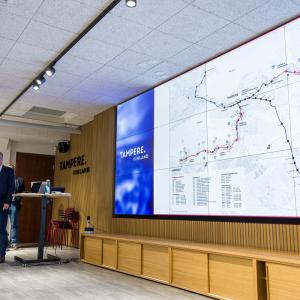Näsisaari has taken shape, nearly a million cubic metres of blasted stone have been transported
For the large part, the Näsisaari waterway fill project is complete, and the island has taken shape. Thus far, a total of one million cubic metres of blasted stone has been transported into Näsisaari and the tramway embankment structures. What now remains are only expansions to be carried out at the edges of the waterway and the construction of preloading embankments and fills in connection with the tramway line. The waterway fill and deep compaction have gone according to plan and schedule. Currently, the work is even ahead of schedule in some areas. The construction of Näsisaari allows the construction of the tramway through the future residential area of Hiedanranta to Lentävänniemi.
The support and excavation work of the 110-kilovolt (kV) power line posts’ foundations related to the Paasikiventie storm water lines and the Vaitinaro waterfront walkway has been met with challenges, but now the pipelines’ installation work and the waterfront walkway’s construction are continuing once again.
Another project carried out in the Lake Näsijärvi beach and waterway area, the condensation water pipe repositioning and installation project, continued and was completed according to plan. The new pipelines were driven into Näsisaari’s Hiedanranta-side end, in connection with the tramway bridges and on the northern side of the island.
Water quality has been carefully monitored throughout the project, and measures have been taken whenever necessary. During the project, 92 groundwater samples and 586 surface water samples have been taken and analysed.
More blasted stone being transported
The pile of blasted stone in Hiedanranta has almost been depleted, but more blasted stone is being transported from other reserves in accordance with the principles of circular economy. The Näsisaari construction project has been in progress since February using blasted stone from the enormous reserve pile at the Hiedanranta-side end. Only roughly 10 per cent remain of the pile, which amounts to approximately 100,000 cubic metres.
Approximately 890,000 cubic metres of blasted stone have been transported for use in the construction of the island, of which the Näsisaari contractor Louhintahiekka Oy has transported approximately 790,000 cubic metres and the Sulkavuori central wastewater treatment plant’s contractor Skanska Infra Oy has transported approximately 100,000 cubic metres.
Blasted stone has been transported from the Pölkkylänniemi-side end as well. The transported volume amounts to approximately 120,000 cubic metres. In total, the waterway fill and the tramway embankments require close to 1.5 million cubic metres of blasted stone.
The penetration levels of the completed fills at the bottom of the lake have been assessed by way of motorised dynamic sounding, and it has been found that, generally around the island area, they are in accordance with the estimations, i.e. one metre above the lake bed. Only in the north-eastern part of the island, in the areas located outside the future tramway line, has the fill penetration been 1–2 metres deeper. In these areas, as early as in the preliminary surveys, slightly thicker silt layers were found on the surface, which have taken slightly more blasted stone to fill than was estimated.
Nearly 40,000 loads of blasted stone
Thus far, the total number of blasted rock loads transported to the island is 39,000. Of these, roughly 7,000 loads were transported through Paasikiventie using semi-trailer equipment, and 32,000 loads were transported through the site roads using heavy earthmoving machines and dumpers.
Around 6,000 loads of blasted rock will be transported from the reserve piles in Lakalaiva and Lahdesjärvi for the tramway embankments and Nasisääri. The blasted stone will be transported through Paasikiventie, Pölkkylänniemi and Hiedanranta-side end. The transport of blasted stone will start on the week of 17 October. Turtolan Kaivin Oy will be responsible for the transport of the blasted stone.
The blasted rock from the tramway line adjacent to Sellupuisto will also be transported to the Näsisaari loading berm in the area on the northern side of the Hiedanranta factory area. The blasted rock, which amounts to 1,500 loads, will be transported to the island through a site road and, in accordance with the principles of circular economy, till will be transported for the preparation of the northern block as a return load. Louhintahiekka Oy will be responsible for this work.
Over half of the compaction work of the waterway fill embankment has been completed. In the deep compaction work carried out thus far, drop balls (weight 10 tonnes and 12 tonnes) have been dropped a total of roughly 59,000 times.
With regard to the wateway fill and the channel’s water exchange, an 80-metre-long steel bridge drum with a diameter of 2.5 metres was installed in the Hiedanranta end adjacent to the future tramway lines. A similar bridge drum was already installed earlier in the Pölkkylänniemi-side end. These bridge drums installed on both sides of the island fill allow for water exchange in the channel following the changes to the protective drapes.
With regard to the construction of the island, the old waterway embankment adjacent to the log-floating tunnel and the dock structure therein will be demolished. The spread of the possibly resulting turbidity into the channel will be prevented through the installation of a protective drape around the work site.
The condition of the protective drapes being constantly monitored
The condition of the protective drapes in the waterway area has been constantly monitored, and the drape floats and fastenings have been fixed when necessary. Slight turbidity has at times been observed outside the protective drapes. The spread of the turbidity has been primarily due to strong winds and heavy rain. The condition of the protective drapes has also been monitored by diving.
At no point have the drapes been observed to have been broken or torn. New protective drapes were installed adjacent to the old demolished condensation water pipeline. With regard to the channel’s water conveyance arrangements, changes have been made to the protective drapes in the Pölkkylänniemi-side waterway areas, and new protective drapes have also been installed.
Water quality of the channel being monitored
Between the mainland and the island fill, the channel’s water quality has been monitored almost weekly. As a result of the heavy rains in late autumn, the storm water from the storm water outfall pipelines of Paasikiventie (VT12) and the road ramp caused turbidity. There had been no problems prior to this. Once the turbidity was detected, water exchange in the channel was boosted.
Functioning uniform protective draping kept the water fogged by Paasikiventie between the channel and the mainland. The water of the channel was cleared quickly, and the channel’s water exchange was boosted through pumping arrangements.
Most of the old outfall pipelines for the storm water from Paasikiventie have already been connected to the new main line, so turbidity will not spread into the channel through there. The erosion protection mat installed in the ramp between Paasikiventie and the waterfront walkway ensures that fine material does not spread to the channel from the ramp.
Water quality in the channel between Näsisaari and the mainland is ensured through aeration in the channel, pumping the water into the channel and through the use of large drum pipes on both sides of the island.
Status of water and sediment monitoring
Water samples have been taken of the Lake Näsijärvi surface water, and oxygen level and turbidity monitoring has been carried out at roughly one-week intervals and more often when necessary. With regard to more extensive surface water monitoring that also covers areas outside the waterway fill area, a monitoring programme following two-week intervals has been implemented.
Where turbidity has been detected in the vicinity of the protective drapes, samples have been taken more frequently, and the cause of the turbidity and its extent have been investigated. With these investigations and quick measures, the situation has been kept under control. The situation in autumn has been good, and the protective drapes have managed to contain any turbidity.
The turbidity observed in the channel waters following heavy rains has been cleared, and the oxygen levels have been restored to a good level between Näsisaari and the mainland through aeration in the channel, pumping water and through the use of two large drum pipes on both sides of the island.
In connection with the groundwater monitoring carried out at the end of September, an additional round of sampling has been carried out, where samples were taken from all nine groundwater pipes in addition to the sampling required by the monitoring programme. Changes related to the island fill have not been observed in earlier groundwater quality monitoring.
The groundwater monitoring results have always been reported to the overseeing authority as soon as they have arrived. At this end of this year, groundwater monitoring in accordance with the monitoring programme will be carried out in late October and in December.
Sedimentary deposits will be monitored through the use of collectors at the bottom of Lake Näsijärvi at three-month intervals. When the water is covered by ice, the sedimentation is generally insignificant, so the taken samples were small and could only be used to assess the rate of sedimentation.
During summer months, the collectors had collected more sediment, which also allowed for the assessment of other harmful substances. The sediment sampling results are reported to the overseeing authority as soon as they arrive.
The results of water and sediment monitoring are reported regularly to the overseeing authority for the project, which is Pirkanmaa Centre for Economic Development, Transport and the Environment.
The work along Paasikiventie is progressing
The construction of the Paasikiventie storm water line and the waterfront walkway is progressing. The storm water line collects the storm water from Paasikiventie and directs it to Possinoja and from there to Lake Näsijärvi in accordance with the Hiedanranta municipal engineering general plan.
The construction of the storm water line and waterfront walkway in the steep Paasikiventie shore ramp began around mid-May. The old Paasikiventie embankment fill materials have caused problems in construction. In connection with the supporting and anchoring of the 110-kilowatt embankment, fill revealed a lot of stone and boulders, which is why the supporting solution was changed. The support solutions based on the set wall and ground anchors showed problems due to the non-uniform nature of the embankment, and more additional anchors had to be drilled than was anticipated.
Now the support and anchoring work has been completed, and the storm water line’s installation work and the waterfront walkway’s construction work are well underway. The goal is to finish the work before the end of November. Ylöjärven Kiviset Oy has been contracted for the project.
The most important function of the storm water line of the waterfront walkway is to collect the water previously drained directly to the shore ramp to a new line and direct it out of the shore channel.
Challenges related to the construction of the storm water lines and waterfront walkway include installing these into the steep ramp and the erosion caused by rain. The ramp remaining in the desired state is ensured through the installation of an erosion protection mat made from biodegradable material, under which a lawn will be sowed.
The power plant’s condensation water pipes already in use
In the Hiedanranta-side, the pipe assembly and water installation work connected to the repositioning of the Lielahti power plant of Tampereen Sähkölaitos’ condensation water pipes, which had been going on from May, has been completed. These new pipelines with a diameter of 0.8 m and 1.2 m and a total length of 1.1 km were deployed in mid-September. Veisu-Tekniikka Oy and LK-Urakointi Oy consortium and Uponor Oy were the contractors responsible for the implementation. The commissioner on behalf of Tampereen Sähkölaitos in the construction project was the City of Tampere, alongside other work related to the island.
Due to the melting of the embankment fills carried out in the winter, the pipes’ positioning line sunk downwards, which made the work more difficult and caused delays. Despite this, the contract requiring challenging and demanding diving and installation work was completed according to plan.
The large pipes were assembled into 200-metre-long lines on top of the embankment, floated in the waterways to where dredging had been carried and descended into a depth of 3–7 metres. In connection with the installation of the pipes, underwater pipe connection work and concrete weight installations were carried out, which posed lots of challenges for the divers due to the turbidity of the water.
The old plastic condensation water pipelines were taken apart. The pipes were raised from the bottom of the lake through the use of pressurised air, transported to land and taken apart. In accordance with the principles of circular economy, the old pipes will be utilised and reused in infrastructure construction.
Sunken logs extensively removed
In relation to the repositioning of the condensation water pipes, sunken logs were extensively removed in the waterway area within the protective drapes. The work was completed in mid-September. The area cleared of sunken logs was nearly 6 hectares in size.
In the area where sunken logs were removed, there was no paper mill sludge, which was also observed during the work. In the northern side of the work site, there is a lot of paper mill sludge. The procurement process for processing the paper mill sludge is underway.
Construction of Näsisaari (in Finnish)
Additional information of Hiedanranta
More information on the construction of the tramway

Further information
Petri Leppänen
City of Tampere, Urban Environment and Infrastructure Services, Construction Construction engineerPhone:
050 305 1402


